Ten Treasures at Stake
New Mining Claims Plus an Old Law Put National Parks and Forests at Risk
As the Obama administration develops its final proposal to protect the Grand Canyon from hardrock mining, other national parks, monuments, forests and historic sites are also under threat from thousands of mining claims, many of them staked during the past five years. These incomparable places could be at risk because of the outdated 1872 Mining Law that puts prospecting ahead of other activities on most of America's public lands.
Congress has repeatedly and unsuccessfully attempted to modernize this statute, despite the fact that even industry experts say it should be updated. But until the law is brought up-to-date, few good options exist for protecting such places as the Grand Canyon from hardrock mining, except for a time-limited “withdrawal process,” which the Obama administration is currently considering. This report provides 10 examples of the lands at risk if Congress and the administration fail to act.
Ten Treasures at Stake:
- Grand Canyon National Park
- Joshua Tree National Park
- Yosemite National Park
- Blackfoot River
- Gila Wilderness
- Siskiyou Wild Rivers Area
- Mount Rushmore National Memorial
- Canyonlands and Arches National Parks
- Dinosaur National Monument
- Mount St. Helens National Volcanic Monument
According to BLM data, there were fewer than 100 mining claims before 1995 in an area known for uranium deposits on the outskirts of Grand Canyon National Park. By 2004, as the price of uranium rose, that number more than tripled, with approximately 320 claims staked in a year. In 2006, a claim-staking frenzy hit the area, resulting in more than 3,200 new claims; and in 2007, when the price of uranium hit a 40-year high, an additional 2,900 claims were staked.
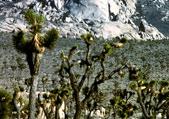 Stargazing, birding and backpacking are favorite activities at this California national park, which features the rare Joshua tree, named by 19th-century Mormon settlers for its resemblance to the biblical figure Joshua reaching to the sky in prayer. More than 18 million people live within a three-hour drive of the park, which encompasses a trio of unique ecosystems and consists largely of wilderness. Joshua Tree straddles the Pacific Flyway and is used as a rest stop by migratory birds. It also provides a haven for the desert tortoise, listed by the U.S. Fish and Wildlife Service as threatened.
Stargazing, birding and backpacking are favorite activities at this California national park, which features the rare Joshua tree, named by 19th-century Mormon settlers for its resemblance to the biblical figure Joshua reaching to the sky in prayer. More than 18 million people live within a three-hour drive of the park, which encompasses a trio of unique ecosystems and consists largely of wilderness. Joshua Tree straddles the Pacific Flyway and is used as a rest stop by migratory birds. It also provides a haven for the desert tortoise, listed by the U.S. Fish and Wildlife Service as threatened.
According to BLM data, 275 active mining claims lie within five miles of Joshua Tree's borders. Of these, more than a quarter have been staked since 2005, most at the park's northern boundary.
Yosemite National Park
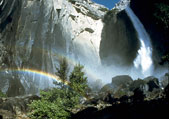 Yosemite National Park, in the heart of California's Sierra Nevada mountains, is one of the nation's first parks. Designated as a World Heritage site in 1984, Yosemite is best known for its giant Half Dome, which towers over deep valleys and lush groves of ancient sequoias. Each year, more than 3.5 million people from around the world come to admire the park's granite cliffs or hike on its 800 miles of trails.
Yosemite National Park, in the heart of California's Sierra Nevada mountains, is one of the nation's first parks. Designated as a World Heritage site in 1984, Yosemite is best known for its giant Half Dome, which towers over deep valleys and lush groves of ancient sequoias. Each year, more than 3.5 million people from around the world come to admire the park's granite cliffs or hike on its 800 miles of trails.
Although Yosemite is one of the most biologically diverse landscapes in the region, BLM data show that roughly 120 mining claims can be found within five miles of the national park. Two-thirds of these have been staked since the beginning of 2006, with 30 claims made in 2009. The Yosemite claims include many located along the Wild and Scenic Merced River and surrounding areas of roadless national forests.
Blackfoot River
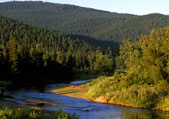 The Blackfoot River begins in western Montana at the Continental Divide. Immortalized in the film “A River Runs Through It” (1992), the river draws canoeists and fly fishermen alike as it travels through Big Sky country toward the Clark Fork River. Portions of the Blackfoot's watershed bear the scars of past mining, but local ranchers and conservationists joined together to establish an award-winning restoration program. Today, conservation easements protect the river, the diverse landscape and a wealth of wildlife.
The Blackfoot River begins in western Montana at the Continental Divide. Immortalized in the film “A River Runs Through It” (1992), the river draws canoeists and fly fishermen alike as it travels through Big Sky country toward the Clark Fork River. Portions of the Blackfoot's watershed bear the scars of past mining, but local ranchers and conservationists joined together to establish an award-winning restoration program. Today, conservation easements protect the river, the diverse landscape and a wealth of wildlife.
The efforts of local leaders could be hindered, however, by approximately 2,250 mining claims in the Blackfoot watershed—more than half of which date from 2006 or later. This recent spike includes the staking of more than 650 claims in 2007 and nearly 285 in 2009.
Gila Wilderness
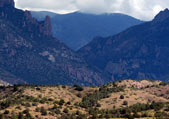 The Gila National Forest in southwestern New Mexico, at 3.3 million acres, is one of the largest national forests in the continental United States. Thanks to scientist and forester Aldo Leopold, a portion of the forest was protected as the world's first designated wilderness. Its rugged terrain ranges from the Rocky Mountains and deep canyons to semidesert, attracting backcountry hiking and hunting enthusiasts.
The Gila National Forest in southwestern New Mexico, at 3.3 million acres, is one of the largest national forests in the continental United States. Thanks to scientist and forester Aldo Leopold, a portion of the forest was protected as the world's first designated wilderness. Its rugged terrain ranges from the Rocky Mountains and deep canyons to semidesert, attracting backcountry hiking and hunting enthusiasts.
But the wilderness that Leopold protected is now threatened by hardrock mining. According to government figures, there are more than two dozen claims in the Gila wilderness and more than 700 in national forest roadless areas surrounding the designated wilderness. Roughly half of the claims have been staked since the beginning of 2006.
Siskiyou Wild Rivers Area
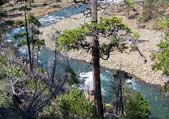 Located in southwestern Oregon, the Siskiyou Wild Rivers area—which includes the Chetco Wild and Scenic River—contains one of the largest remaining complexes of wilderness and unprotected roadless areas on the Pacific coast. This landscape of forested peaks and sparkling mountain rivers supports salmon runs and thousands of plant and animal species, some of which are found nowhere else.
Located in southwestern Oregon, the Siskiyou Wild Rivers area—which includes the Chetco Wild and Scenic River—contains one of the largest remaining complexes of wilderness and unprotected roadless areas on the Pacific coast. This landscape of forested peaks and sparkling mountain rivers supports salmon runs and thousands of plant and animal species, some of which are found nowhere else.
Nevertheless, the entire area has been peppered with mining claims, including about 45 that lie near a portion of the Chetco and in nearby roadless forests. BLM data show that more than half of the claims have been staked since 2000. In 2001, a proposed 4,000-acre mine near Rough and Ready Creek prompted the Clinton administration to withdraw more than 150,000 acres from new claim staking. However, the withdrawal for most of that area—118,000 acres—was reversed by the Bush administration in 2003. Today, the state's top officials, including U.S. Sens. Ron Wyden and Jeff Merkley and U.S. Rep. Peter DeFazio, have called for reinstatement of the withdrawal.
Mount Rushmore National Memorial
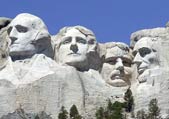 Mount Rushmore—with its stone-carved images of Presidents George Washington, Thomas Jefferson, Abraham Lincoln and Theodore Roosevelt—is one of the nation's most recognizable landmarks. Each year, nearly 3 million people from around the world visit the Black Hills to marvel at this monumental granite sculpture by Gutzon Borglum, which took nearly two decades to complete.
Mount Rushmore—with its stone-carved images of Presidents George Washington, Thomas Jefferson, Abraham Lincoln and Theodore Roosevelt—is one of the nation's most recognizable landmarks. Each year, nearly 3 million people from around the world visit the Black Hills to marvel at this monumental granite sculpture by Gutzon Borglum, which took nearly two decades to complete.
But there are roughly 40 active mining claims within five miles of this stunning memorial in the Black Hills National Forest. More than a third have been staked from 2007 to the present.
Canyonlands and Arches National Parks
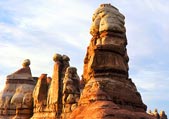 Like the Grand Canyon in Arizona, Utah's Canyonlands National Park is a vast system of colorful canyons, mesas and buttes carved out of rock over millennia by the Colorado River and its tributaries. The deep gorges of layer-cake sedimentary rock provide valuable clues to life more than 300 million years ago. American author Edward Abbey, a frequent visitor, described the Canyonlands as “the most weird, wonderful, magical place on earth—there is nothing else like it anywhere.”
Like the Grand Canyon in Arizona, Utah's Canyonlands National Park is a vast system of colorful canyons, mesas and buttes carved out of rock over millennia by the Colorado River and its tributaries. The deep gorges of layer-cake sedimentary rock provide valuable clues to life more than 300 million years ago. American author Edward Abbey, a frequent visitor, described the Canyonlands as “the most weird, wonderful, magical place on earth—there is nothing else like it anywhere.”
To the north of Canyonlands, Arches National Park protects more than 2,000 sandstone arches created from deposits of an ancient sea some 300 million years ago. Today this geological wonder attracts about 860,000 visitors a year. Situated in the heart of the Colorado Plateau desert, the park serves not only as a tourist destination but also as home to a wide range of species, including peregrine falcons, bighorn sheep and mule deer.
In recent years, however, the area between Arches and Canyonlands national parks has drawn numerous mining claims; roughly 950 have been made within five miles of the boundaries of the two parks. Ninety-nine percent of the claims have been staked since the beginning of 2005.
Dinosaur National Monument
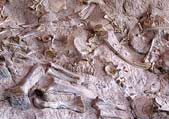 Dinosaur National Monument lies in the rocky hills along the Utah-Colorado line. The site was designated by President Woodrow Wilson in 1915 to protect a large deposit of Jurassic-period dinosaur fossils found in an ancient riverbed and estimated to be 150 million years old. In February 2010, paleontologists uncovered evidence of a new dinosaur species near the monument, reinforcing its importance to scientists and tourists alike as a window into prehistoric life.
Dinosaur National Monument lies in the rocky hills along the Utah-Colorado line. The site was designated by President Woodrow Wilson in 1915 to protect a large deposit of Jurassic-period dinosaur fossils found in an ancient riverbed and estimated to be 150 million years old. In February 2010, paleontologists uncovered evidence of a new dinosaur species near the monument, reinforcing its importance to scientists and tourists alike as a window into prehistoric life.
Today, however, about 35 mining claims are within roughly five miles of the park boundary and near the banks of the Green River, a major tributary of the Colorado. Ten of these claims were staked in 2008 and 2009.
Mount St. Helens National Volcanic Monument
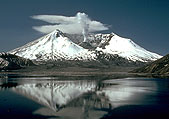 Thirty years ago, Mount St. Helens exploded in one of the most powerful volcanic eruptions ever recorded. Today, the once devastated landscape has begun to recover, giving scientists an unmatched laboratory in which to study natural regeneration after a massive disturbance. In the area that has been designated a national monument, visitors can see clear evidence of loss and regrowth, and still enjoy the landscapes that escaped the worst of the eruption. In the Green River Valley area, stands of old growth Douglas fir survived, along with hillside meadows supporting herds of North American elk. The Green River is home to threatened populations of winter steelhead and fall chinook salmon.
Thirty years ago, Mount St. Helens exploded in one of the most powerful volcanic eruptions ever recorded. Today, the once devastated landscape has begun to recover, giving scientists an unmatched laboratory in which to study natural regeneration after a massive disturbance. In the area that has been designated a national monument, visitors can see clear evidence of loss and regrowth, and still enjoy the landscapes that escaped the worst of the eruption. In the Green River Valley area, stands of old growth Douglas fir survived, along with hillside meadows supporting herds of North American elk. The Green River is home to threatened populations of winter steelhead and fall chinook salmon.
According to federal data, nearly 60 claims have been made within five miles of Mount St. Helens, almost all of them staked in 2004. Some of these claims are near the Green River and in roadless national forest areas north of the volcano and the monument boundary. Others are in proximity to landholdings purchased from the federal government by mining interests under the 1872 Mining Law and reacquired by the U.S. Forest Service with U.S. Treasury monies through the Land and Water Conservation Fund. Plans for a massive copper mine in the area were put on hold after a public outcry in 2008, but new interest in the area by Canadian-based mining companies could result in a large-scale mine on the edge of the monument boundary.






